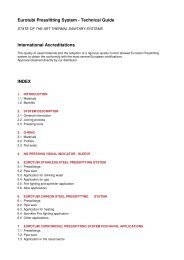Vis PDF - Damstahl
Vis PDF - Damstahl
Vis PDF - Damstahl
Create successful ePaper yourself
Turn your PDF publications into a flip-book with our unique Google optimized e-Paper software.
Chapter 6: The Manufacturing of Stainless Steel and how it affects the Corrosion Resistance<br />
No matter how the stainless steel is used, a certain degree of manufacturing is required. This may<br />
include cutting, bending, welding or grinding; however, no matter what we do, the corrosion resistance<br />
of the steel is affected.<br />
When the stainless steel leaves the factory, it is “perfect”. From this moment, its corrosion resistance<br />
is at its best, and the vast majority of manufacturing processes affect the resistance in a<br />
negative way. Most processes will tend to weaken the corrosion resistance, and, consequently, all<br />
manufacturing should be performed in such a way that the negative effect is as small as possible. If<br />
this is not possible, the manufacturing should be followed by a chemical surface treatment (Chapter<br />
7).<br />
Welding<br />
One of the most severe processes is welding. Apart from introducing a second phase (the filler<br />
metal), the steel is subject to a very powerful heat treatment, which may affect the corrosion resistance<br />
in a number of different ways. All negative, of course.<br />
The risk of corrosion connected to the weld itself is often reduced by choosing a filler metal with a<br />
higher content of Cr and Mo than the base metal. Still, any crevice caused by inadequate binding,<br />
pores or so, and suddenly, one has to cope with the risk of crevice corrosion (Chapter 4).<br />
A rule of the thumb states that CC occurs at a temperature 20-25 °C below the critical pitting temperature<br />
(CPT). To cope with this, crevices should be completely avoided below the water line (=<br />
intensified control), or a better steel with a higher PREN should be chosen. Thereby, a larger safety<br />
margin is induced allowing a few more “defects”.<br />
Schematic drawing showing the various effects on a weld:<br />
A: Base metal<br />
B: Weld / filler metal<br />
C: Natural, protective oxide film<br />
D: Heat tinting<br />
E: Chrome poor layer (underneath the heat tinting)<br />
F: Heat Affected Zone (HAZ)<br />
G: Pores and other crevices<br />
Heating the steel to a temperature in between<br />
500 and 850 ºC, an inevitable phenomenon<br />
close to the welding zone, implies<br />
a risk of formation of harmful chromium<br />
carbides. This does not happen in the weld<br />
itself, but rather in the Heat Affected Zone<br />
(HAZ), close by. Normally, this problem is<br />
greatest when welding thick steel plates,<br />
and in practice, one can cope with it by<br />
choosing low-carbon steel (4306, 4307 or<br />
4404), or titanium stabilized steel (4541 or<br />
4571, Chapter 4).<br />
A related phenomenon is the formation of<br />
harmful intermetallic phases such as the<br />
“sigma” (Cr-Fe) or the “ksi” phase (Cr-Mo).<br />
This problem is particularly big when welding<br />
high-alloyed “super duplex” steels<br />
(i.e. 4410, duplex 2507 and Zeron 100) and<br />
the highend ferritic steel types (i.e. 4509,<br />
4526 and 4521).<br />
www.damstahl.com<br />
01.2013<br />
306
















